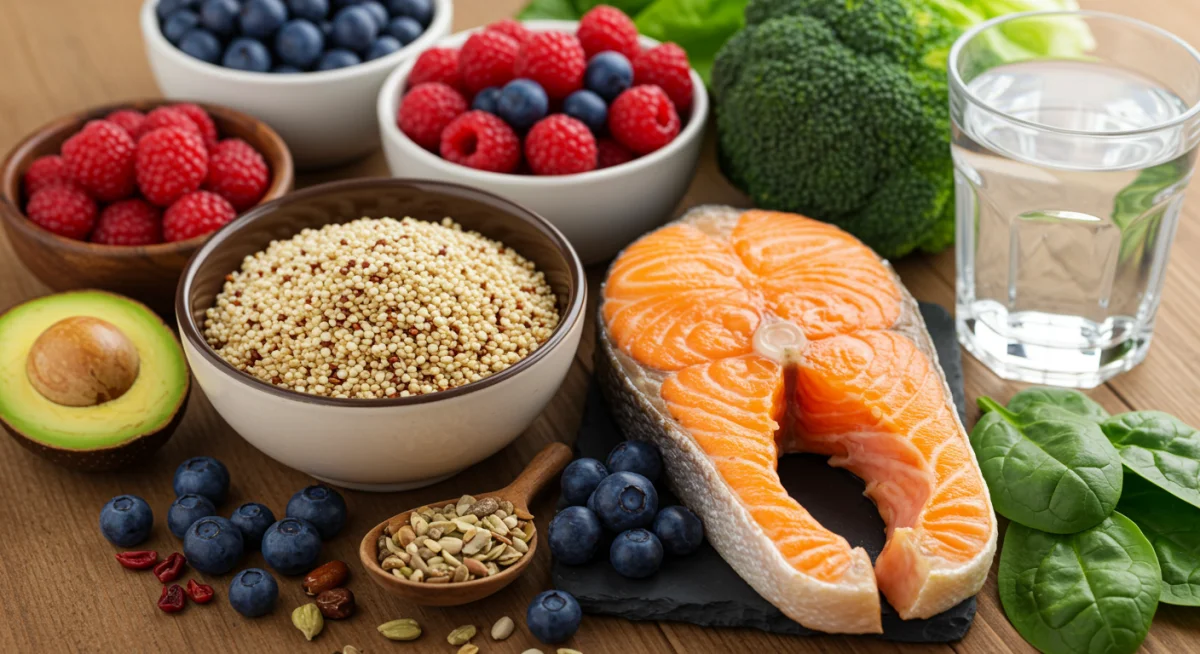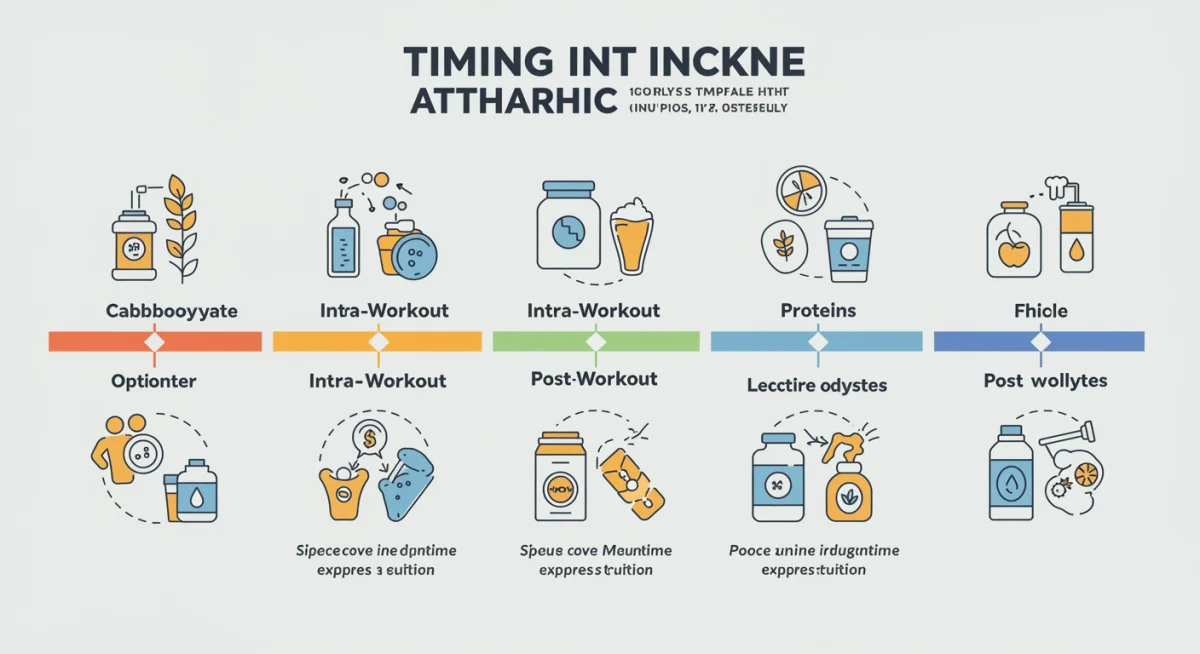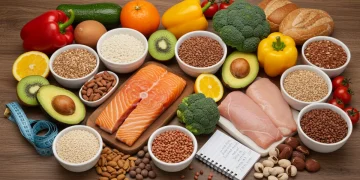Optimize Performance: 2025 Athletic Nutrition Blueprint

This blueprint details the essential nutritional strategies for athletes in 2025, focusing on advanced dietary approaches to maximize endurance, strength, and overall athletic performance through practical, science-backed solutions.
Are you an athlete striving for that competitive edge? In the ever-evolving world of sports, staying ahead means embracing the latest science. This article delves into athletic nutrition blueprint, offering a comprehensive guide to fuel your body for unparalleled endurance and strength in 2025.
The Foundation of Peak Performance: Macronutrient Mastery
Achieving elite athletic performance begins with a meticulous understanding and application of macronutrients. Carbohydrates, proteins, and fats are not merely food components; they are the fundamental building blocks and primary energy sources that dictate an athlete’s capacity for training, competition, and recovery. In 2025, the focus intensifies on personalized macronutrient ratios, moving beyond generic recommendations to tailor intake based on individual metabolic rates, training intensity, and specific athletic goals.
Carbohydrates, often misunderstood, remain paramount for energy. They are stored as glycogen in muscles and the liver, providing readily available fuel for high-intensity activities. Proteins are crucial for muscle repair, growth, and immune function, especially vital for strength athletes and those undergoing rigorous training. Fats, while energy-dense, also play critical roles in hormone production, nutrient absorption, and long-term energy reserves, particularly for endurance athletes.
Carbohydrate Strategies for Sustained Energy
The type and timing of carbohydrate intake are as important as the quantity. Athletes should prioritize complex carbohydrates for sustained energy release and simple carbohydrates strategically for immediate fuel before or during intense sessions.
- Pre-Workout: Opt for easily digestible complex carbs like oats or whole-grain bread 2-3 hours before training.
- Intra-Workout: For prolonged activities, use simple sugars from sports drinks or gels to maintain blood glucose levels.
- Post-Workout: Rapidly replenish glycogen stores with quick-absorbing carbs such as fruits or white rice within 30-60 minutes.
Protein Intake for Muscle Repair and Growth
Protein is non-negotiable for any athlete. The goal is to consume a consistent supply throughout the day to support continuous muscle protein synthesis. Diverse protein sources offer a complete amino acid profile essential for optimal recovery and adaptation.
Aim for 1.6-2.2 grams of protein per kilogram of body weight, distributed across meals and snacks. Incorporate lean meats, poultry, fish, eggs, dairy, and plant-based options like legumes and tofu. Post-exercise, a protein shake or a meal rich in protein and carbohydrates accelerates recovery.
The Role of Healthy Fats
Healthy fats are vital for overall health and athletic performance, supporting hormone regulation and providing a concentrated energy source. They should constitute 20-35% of total daily caloric intake.
- Monounsaturated Fats: Found in avocados, nuts, and olive oil, these support heart health.
- Polyunsaturated Fats: Omega-3 fatty acids from fatty fish, flaxseeds, and walnuts are critical for reducing inflammation and aiding recovery.
- Avoid Trans Fats: These offer no health benefits and can negatively impact cardiovascular health.
Mastering macronutrient intake is the cornerstone of any effective athletic nutrition blueprint. By understanding the specific roles of carbohydrates, proteins, and fats, and by customizing their consumption to individual needs, athletes can unlock their full potential, ensuring optimal energy, recovery, and sustained performance.
Micronutrients and Hydration: The Unsung Heroes
While macronutrients provide the bulk of energy, micronutrients and proper hydration are equally critical, often acting as the silent orchestrators of athletic success. Vitamins, minerals, and water facilitate countless bodily functions, from energy production to immune defense and nerve signaling. Their adequate intake ensures that all metabolic pathways operate efficiently, preventing deficiencies that can significantly impair performance and overall health.
For athletes, heightened physical demands increase the need for specific micronutrients. Electrolytes, for instance, are lost through sweat and must be replenished to maintain fluid balance and prevent muscle cramps. Antioxidant vitamins help combat oxidative stress generated during intense exercise, supporting faster recovery. Understanding these nuances is key to a robust athletic nutrition blueprint.
Essential Vitamins for Athletes
A broad spectrum of vitamins is necessary for optimal athletic function. Some stand out for their direct impact on energy metabolism, bone health, and immune support.
- Vitamin D: Crucial for bone health, muscle function, and immune system regulation. Many athletes are deficient, making supplementation often necessary.
- B Vitamins: Play a vital role in converting food into energy. Deficiencies can lead to fatigue and reduced performance.
- Vitamin C & E: Powerful antioxidants that help protect cells from exercise-induced damage and support immune function.
Minerals That Matter: Iron, Calcium, and Zinc
Minerals are indispensable for numerous physiological processes. Iron, calcium, and zinc are particularly important for athletes due to their roles in oxygen transport, bone density, and immune health.
Iron is essential for hemoglobin production, which carries oxygen to working muscles. Low iron levels can lead to anemia and severe fatigue. Calcium is fundamental for strong bones and muscle contraction, while zinc supports immune function and wound healing. A varied diet rich in fruits, vegetables, whole grains, and lean proteins typically provides sufficient amounts, but athletes should monitor their levels, especially iron.
Hydration Strategies for Optimal Performance
Dehydration, even mild, can severely compromise athletic performance, affecting strength, endurance, and cognitive function. Proper hydration is a continuous process, not just something to consider during exercise.
- Pre-Hydration: Drink 16-20 ounces of water 2-3 hours before exercise.
- During Exercise: Consume 6-12 ounces every 15-20 minutes, adjusting based on sweat rate and environmental conditions. For sessions longer than an hour, consider electrolyte-rich sports drinks.
- Post-Exercise: Replenish fluids by drinking 16-24 ounces of fluid for every pound of body weight lost during exercise.
The meticulous attention to micronutrients and hydration provides the essential support system for an athlete’s body to perform at its peak. Neglecting these elements can undermine the benefits of even the most well-planned macronutrient intake, highlighting their importance in a holistic nutritional strategy.
Nutrient Timing: Maximizing Absorption and Recovery
Nutrient timing is a strategic approach to consuming macronutrients and micronutrients around training sessions to optimize performance, enhance recovery, and facilitate adaptation. It’s not just about what you eat, but when you eat it. The concept revolves around leveraging the body’s physiological responses to exercise, such as increased insulin sensitivity and heightened muscle protein synthesis, to maximize nutrient uptake and utilization.
For athletes seeking to gain a competitive edge, precise nutrient timing can make a significant difference in energy levels during workouts, the speed of muscle repair, and the overall effectiveness of training. This specialized aspect of an athletic nutrition blueprint focuses on three critical windows: pre-workout, intra-workout, and post-workout.

Pre-Workout Nutrition: Fueling for Success
The goal of pre-workout nutrition is to provide sustained energy, prevent hunger, and minimize gastrointestinal distress during exercise. This typically involves a balanced meal or snack consumed 1-3 hours before training.
- Carbohydrates: Focus on complex carbs for sustained energy release (e.g., oatmeal, whole-wheat toast).
- Protein: Include a small amount of lean protein to reduce muscle breakdown (e.g., Greek yogurt, a hard-boiled egg).
- Fats: Keep fat intake low to avoid digestive issues during exercise.
Intra-Workout Nutrition: Sustaining Performance
For workouts lasting longer than 60-90 minutes, especially endurance activities, intra-workout nutrition becomes crucial to maintain energy levels and prevent fatigue. This usually involves easily digestible carbohydrates and electrolytes.
Sports drinks, energy gels, or diluted fruit juices can provide quick sugars and essential electrolytes like sodium and potassium, which are lost through sweat. The exact amount will depend on the intensity, duration, and individual sweat rate, but generally, 30-60 grams of carbohydrates per hour is a good starting point for prolonged efforts.
Post-Workout Nutrition: The Golden Window for Recovery
The period immediately following exercise, often referred to as the “anabolic window,” is critical for replenishing glycogen stores and initiating muscle repair. Consuming a combination of carbohydrates and protein within 30-60 minutes post-exercise is highly beneficial.
- Carbohydrates: Aim for 1-1.2 grams per kilogram of body weight to quickly refill muscle glycogen.
- Protein: Consume 0.3-0.5 grams per kilogram of body weight to stimulate muscle protein synthesis and repair damaged tissues.
- Hydration: Continue to rehydrate with water and electrolytes.
By strategically timing nutrient intake, athletes can optimize their body’s ability to perform, recover, and adapt to training stressors, thereby maximizing their potential for both endurance and strength gains. This precision in fueling is a hallmark of advanced athletic nutrition.
Supplementation: Strategic Enhancements, Not Substitutes
In the pursuit of optimizing athletic performance, supplementation often enters the conversation. However, it’s crucial to understand that supplements are intended to complement, not replace, a well-structured whole-food diet. For 2025, the emphasis remains on evidence-based supplementation, prioritizing products with proven efficacy and safety. The market is saturated with various options, making informed choices vital for athletes looking to enhance their athletic nutrition blueprint responsibly.
The role of supplements is to address specific nutritional gaps, improve recovery, or directly enhance performance under certain conditions. They should be chosen cautiously, ideally with guidance from a sports nutritionist or healthcare professional, to ensure they align with individual needs and do not pose any health risks or violate anti-doping regulations.
Key Performance-Enhancing Supplements
Several supplements have a strong scientific backing for their benefits in athletic populations.
- Creatine Monohydrate: Widely researched, it enhances strength, power, and muscle mass, particularly in high-intensity, short-duration activities.
- Whey Protein: A fast-digesting protein source, ideal for post-workout recovery to stimulate muscle protein synthesis.
- Caffeine: Known to improve endurance performance, reduce perceived exertion, and enhance focus.
Supplements for Recovery and Health
Beyond direct performance enhancement, some supplements aid in recovery, reduce inflammation, and support overall athlete health.
Omega-3 fatty acids, typically from fish oil, are renowned for their anti-inflammatory properties, which can aid in muscle soreness and joint health. Vitamin D, as mentioned earlier, is vital for bone health and immune function, and supplementation is often recommended due to widespread deficiency. Probiotics can support gut health, which is increasingly recognized for its impact on immune function and nutrient absorption.
Navigating the Supplement Landscape
The supplement industry is largely unregulated, leading to concerns about product quality, purity, and efficacy. Athletes must exercise due diligence.
- Third-Party Testing: Look for certifications from organizations like NSF Certified for Sport or Informed-Sport, which verify product contents and test for banned substances.
- Dosage and Timing: Adhere to recommended dosages and understand the optimal timing for supplement intake to maximize benefits and minimize side effects.
- Individual Response: Recognize that not all supplements work for everyone, and individual responses can vary.
Strategic supplementation, when approached with knowledge and caution, can be a valuable component of an athlete’s nutritional strategy. It serves as a fine-tuning mechanism, providing targeted support to help athletes achieve their peak potential without compromising their health or ethical standards.
Personalized Nutrition: The Future of Athletic Fueling
The era of one-size-fits-all nutrition is rapidly fading, especially in elite sports. Personalized nutrition, driven by advancements in genomics, metabolomics, and wearable technology, represents the cutting edge of an athletic nutrition blueprint for 2025. This approach recognizes that each athlete is biochemically unique, with distinct nutritional requirements influenced by genetics, gut microbiome composition, training load, environmental factors, and individual goals.
Personalized nutrition moves beyond general dietary guidelines, offering bespoke recommendations that are finely tuned to an individual’s specific physiological profile. This level of customization promises to unlock unprecedented levels of performance optimization and injury prevention, making every dietary choice a precise, data-driven decision.
Genomic and Microbiome Insights
Understanding an athlete’s genetic predispositions can reveal how they metabolize certain nutrients, their susceptibility to deficiencies, and their response to different dietary interventions. For example, some individuals may have genetic variations that influence their caffeine metabolism or their need for specific vitamins.
Similarly, the gut microbiome, the complex community of microorganisms residing in the digestive tract, plays a profound role in nutrient absorption, immune function, and even mood. Analyzing an athlete’s microbiome can inform dietary strategies to optimize gut health, which in turn can enhance nutrient utilization and overall well-being.
Wearable Technology and Real-Time Monitoring
Wearable devices have transformed how athletes monitor their bodies. Beyond tracking heart rate and sleep, advanced wearables can now provide insights into hydration status, glucose levels, and even metabolic responses to food in real-time.
- Continuous Glucose Monitors (CGMs): Offer real-time data on blood sugar responses to different foods and exercise, allowing for immediate adjustments to carbohydrate intake.
- Advanced Biometric Sensors: Track sweat rate, electrolyte loss, and core body temperature, providing precise data for personalized hydration and electrolyte replacement strategies.
- Sleep and Recovery Trackers: Integrate with nutritional data to show how diet impacts recovery metrics, guiding adjustments for optimal rest and repair.
Tailoring Meal Plans and Supplementation
With personalized data, nutritionists can create highly specific meal plans that account for an athlete’s unique metabolic needs, food preferences, and training schedule. This includes precise macronutrient ratios, specific food choices, and tailored timing of meals and snacks.
Supplementation also becomes more targeted. Instead of broad recommendations, personalized insights can identify specific deficiencies or areas where a particular supplement might offer a significant, evidence-based benefit, moving away from a trial-and-error approach.
The integration of cutting-edge science and technology into personalized nutrition is revolutionizing how athletes approach their diets. By embracing this tailored approach, athletes can optimize every aspect of their fueling strategy, leading to superior performance, faster recovery, and a longer, healthier athletic career.
Recovery Nutrition: The Key to Sustained Progress
Recovery is not merely rest; it’s an active process where the body repairs, adapts, and grows stronger in response to training stress. Central to this process is recovery nutrition, a critical component of any effective athletic nutrition blueprint. Neglecting proper post-exercise fueling can undermine training efforts, increase the risk of injury, and lead to overtraining syndrome. In 2025, the emphasis on recovery nutrition is more pronounced than ever, recognizing its pivotal role in sustained athletic progress.
Effective recovery nutrition aims to replenish depleted energy stores, repair muscle tissue damaged during exercise, reduce inflammation, and rehydrate the body. This multi-faceted approach ensures that athletes are not only ready for their next training session but are also continuously improving and adapting.

Post-Exercise Fueling: The Golden Hour
The period immediately following strenuous exercise, often referred to as the “golden hour,” is when the body is most receptive to nutrient uptake. Consuming a well-balanced meal or snack within 30-60 minutes post-workout is crucial.
- Carbohydrates: Replenish muscle glycogen. Aim for high glycemic index carbs for rapid absorption (e.g., fruit, white rice, sports drinks).
- Protein: Provide amino acids for muscle repair and synthesis. Whey protein is an excellent choice due to its rapid digestion.
- Electrolytes: Restore fluid balance by consuming sodium and potassium, especially after heavy sweating.
Anti-Inflammatory Foods for Faster Recovery
Intense exercise induces a degree of inflammation, which is part of the adaptation process but can also contribute to muscle soreness and delayed recovery. Incorporating anti-inflammatory foods into the daily diet can help manage this response.
Foods rich in antioxidants and omega-3 fatty acids are particularly beneficial. Berries, leafy greens, fatty fish (salmon, mackerel), nuts, and seeds all possess powerful anti-inflammatory properties. Turmeric and ginger are also well-known for their anti-inflammatory effects and can be incorporated into meals or smoothies.
Sleep and Recovery: The Unseen Link
While nutrition plays a direct role, adequate sleep is a non-negotiable component of recovery. During sleep, the body releases growth hormone, which is vital for tissue repair and growth. Nutritional strategies can support sleep quality.
- Magnesium: Can help improve sleep quality; found in leafy greens, nuts, and whole grains.
- Tryptophan: A precursor to serotonin and melatonin, which regulate sleep; found in turkey, milk, and oats.
- Avoid Caffeine and Heavy Meals: Limit caffeine intake late in the day and avoid large, heavy meals close to bedtime.
Prioritizing recovery nutrition is an investment in an athlete’s long-term health and performance. By systematically replenishing, repairing, and rehydrating, athletes can maximize their training adaptations, minimize downtime, and consistently perform at their highest level.
Practical Solutions for the Modern Athlete
Translating advanced nutritional science into everyday practice can be challenging for busy athletes. The 2025 athletic nutrition blueprint emphasizes practical, actionable solutions that fit into demanding training schedules and lifestyles. It’s not enough to know what to eat; athletes need strategies for how to prepare, plan, and consume their fuel efficiently and effectively. This section focuses on integrating cutting-edge nutritional principles into a manageable routine, ensuring sustained adherence and maximizing results.
The key lies in simplification, meal prepping, and smart snacking. Athletes often juggle training, work, and personal commitments, making time a precious commodity. By adopting streamlined approaches, they can consistently meet their nutritional needs without feeling overwhelmed, turning healthy eating into a seamless part of their athletic journey.
Meal Prepping and Planning
One of the most effective strategies for maintaining consistent nutrition is meal prepping. Dedicating a few hours once or twice a week to prepare meals and snacks for the days ahead can save significant time and ensure nutrient-dense options are always available.
- Batch Cooking: Prepare large quantities of staples like grilled chicken, roasted vegetables, quinoa, or brown rice.
- Portioning: Divide cooked meals into individual containers for easy grab-and-go options.
- Strategic Shopping: Plan grocery lists based on your weekly meal plan to avoid impulse buys and ensure all necessary ingredients are on hand.
Smart Snacking for Continuous Fuel
Snacks are not just for curbing hunger; they are vital opportunities to provide continuous fuel, support recovery, and meet high caloric demands. Smart snack choices can prevent energy dips and maintain stable blood sugar levels throughout the day.
Focus on nutrient-dense options that offer a balance of macronutrients. Examples include Greek yogurt with berries, a handful of nuts and a piece of fruit, rice cakes with avocado, or a small protein shake. These choices provide sustained energy and essential nutrients without being overly filling or causing digestive upset.
Staying Hydrated On-the-Go
Maintaining optimal hydration often requires conscious effort. Carrying a reusable water bottle and setting reminders can help ensure consistent fluid intake throughout the day, not just during workouts.
- Electrolyte Tabs: For long training sessions or hot environments, consider adding electrolyte tablets to water for convenient replenishment.
- Fluid-Rich Foods: Incorporate fruits and vegetables with high water content, such as watermelon, cucumbers, and oranges, into your diet.
- Monitor Urine Color: A simple visual cue; aim for light yellow urine as an indicator of good hydration.
By implementing these practical solutions, athletes can seamlessly integrate optimal nutrition into their demanding lifestyles. These strategies transform the theoretical aspects of an athletic nutrition blueprint into tangible, daily habits that support peak performance and overall well-being.
The Mental Edge: Nutrition’s Impact on Cognitive Function
While physical prowess is paramount in athletics, the mental game is equally, if not more, critical. An athlete’s ability to focus, make quick decisions, and maintain composure under pressure is heavily influenced by their nutritional status. The 2025 athletic nutrition blueprint recognizes the profound link between diet and cognitive function, emphasizing nutrients that support brain health and mental resilience. This holistic approach ensures that athletes are not only physically prepared but also mentally sharp and ready to perform at their best.
The brain, despite being only about 2% of body weight, consumes a disproportionately high amount of energy. It relies on a steady supply of glucose and specific micronutrients to function optimally. Deficiencies or inconsistent fueling can lead to decreased concentration, slower reaction times, and increased irritability, all of which can severely impact performance.
Omega-3 Fatty Acids for Brain Health
Omega-3 fatty acids, particularly DHA (docosahexaenoic acid), are essential components of brain cell membranes. They play a crucial role in cognitive functions such as memory, attention, and mood regulation. For athletes, this translates to improved focus and better decision-making during competition.
- Sources: Fatty fish (salmon, mackerel, sardines), flaxseeds, chia seeds, and walnuts.
- Supplementation: Fish oil supplements can ensure adequate intake, especially for those who don’t consume enough dietary sources.
B Vitamins and Neurotransmitter Synthesis
B vitamins are vital cofactors in the synthesis of neurotransmitters, the chemical messengers in the brain. They are involved in energy production within brain cells and contribute to overall neurological health.
Folate (B9), B6, and B12 are particularly important for mood regulation and cognitive sharpness. Deficiencies can lead to fatigue, poor concentration, and even depression, all detrimental to an athlete’s mental state. Ensuring a diet rich in whole grains, leafy greens, lean meats, and dairy products can provide ample B vitamins.
Antioxidants for Cognitive Protection
Intense physical activity can increase oxidative stress throughout the body, including the brain. Antioxidants help neutralize free radicals, protecting brain cells from damage and supporting long-term cognitive health.
- Vitamin C & E: Found in citrus fruits, berries, nuts, and seeds.
- Flavonoids: Abundant in colorful fruits and vegetables, green tea, and dark chocolate.
- Polyphenols: Present in coffee, tea, and many plant-based foods, offering neuroprotective benefits.
By intentionally incorporating brain-boosting nutrients into their diet, athletes can cultivate a robust mental edge. This focus on cognitive nutrition ensures that the mind is as finely tuned as the body, allowing for optimal performance both on and off the field.
| Key Point | Brief Description |
|---|---|
| Macronutrient Balance | Customizing carbohydrate, protein, and fat intake for individual energy, repair, and hormonal needs. |
| Nutrient Timing | Strategically consuming nutrients pre-, intra-, and post-workout to optimize performance and recovery. |
| Personalized Nutrition | Utilizing genomic, microbiome, and real-time data for tailored dietary recommendations. |
| Recovery Focus | Emphasizing post-exercise fueling, anti-inflammatory foods, and sleep for sustained progress. |
Frequently Asked Questions About Athletic Nutrition
Athletes should aim for 3 main meals and 2-3 snacks daily, distributing macronutrients evenly. This approach helps maintain stable energy levels, supports continuous muscle protein synthesis, and prevents excessive hunger, which is crucial for consistent performance and recovery.
Absolutely. Well-planned plant-based diets can fully support athletic performance. Key considerations include ensuring adequate protein intake from diverse sources, monitoring iron and B12 levels, and consuming enough calories to meet energy demands. Consultation with a nutritionist can help optimize the plan.
The best electrolytes for athletes are sodium, potassium, calcium, and magnesium. Sodium is crucial for fluid balance and nerve function, while potassium aids muscle contraction. Calcium supports bone health, and magnesium contributes to muscle relaxation. These are typically found in sports drinks or electrolyte supplements.
To prevent digestive issues, athletes should avoid high-fiber, high-fat, and spicy foods immediately before training. Opt for easily digestible complex carbohydrates and lean proteins. Experiment with different foods during training to find what works best, and ensure adequate hydration without overconsuming fluids.
Yes, carbohydrate loading remains a valuable strategy for endurance athletes participating in events lasting longer than 90 minutes. It involves increasing carbohydrate intake for 1-3 days before competition to maximize muscle glycogen stores, providing a larger fuel reserve for sustained performance.
Conclusion
The journey to optimizing athletic performance in 2025 is intricately linked with a sophisticated and personalized approach to nutrition. By mastering macronutrients, prioritizing micronutrients and hydration, strategically timing nutrient intake, and leveraging evidence-based supplementation, athletes can significantly enhance their endurance, strength, and overall physical capabilities. Furthermore, recognizing the profound impact of nutrition on cognitive function and prioritizing robust recovery strategies are essential for sustained progress and mental resilience. The future of athletic fueling is dynamic, data-driven, and highly individualized, empowering athletes to unlock their full potential and achieve unparalleled success in their chosen disciplines.





